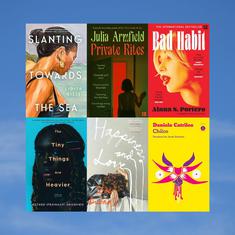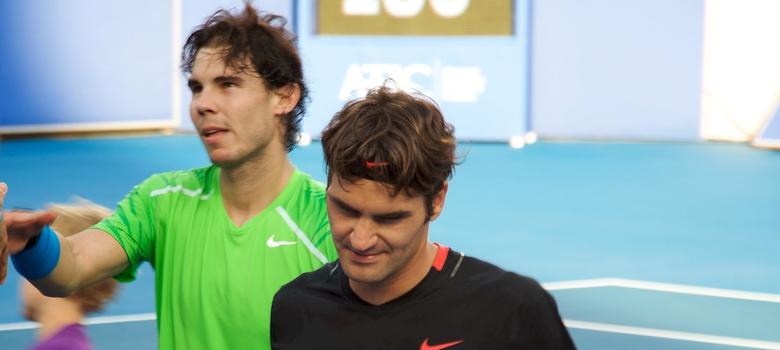The 2015 International Premier Tennis League promises to gift Indian tennis fans a taste of modern tennis’s greatest rivalry, Roger Federer versus Rafael Nadal, on the final day of the India leg to be held in Delhi from 10-12 December. This will come a year after the capital had the privilege of hosting a one-setter between Federer and world number one Novak Djokovic in the IPTL’s inaugural season.
Nadal, who missed last season due to injury and was subsequently replaced by Federer, will finally join defending champions Indian Aces. In the marquee player merry-go-round (decided via a players’ draft held in April), Federer will play for the UAE Royals while Djokovic will line up for the Singapore Slammers.
Both Leander Paes and Kei Nishikori will also make their IPTL debuts for a new team called the Japan Warriors (the league’s fifth team). Paes’s presence, in particular, is seen as a key endorsement to the IPTL considering he had declined to play last year after reportedly expressing doubts over the league’s sustainability and transparency.
Why? Why? Why?
It’s not yet clear though why tennis even needs such a league. Even less so when it’s positioned as a fast-paced, television-friendly version of a sport that is faster than ever and continues to captivate its ever-expanding global following.
Is tennis in danger of losing its audience? Does it often fail to excite in its current format? No. Arguably no other sport delivers on the hype and expectation (especially surrounding big matches) as much as and as often as tennis does. In fact, the longer a tennis match, the more exciting it becomes – quite a rare trait in modern sport.
Does tennis need to expand to and explore new territories? Yes. Although this is where the IPTL is of some use, it isn’t an area the sport is struggling to deal with. Over the last three decades, both men’s and women’s tennis has seen phenomenal global growth which has curtailed the dominance of a select few countries. Tennis certainly doesn’t need to alter its rules and present itself differently to gain traction.
That the IPTL originates in India, a nation today obsessed with franchise-based leagues, is quite telling. Over a better part of the last decade the country has been bridging the gap between sport, entertainment and business via the introduction of such leagues in various sports: cricket, hockey, badminton, football, kabaddi and finally tennis.
Except tennis, though, each of the above at least retains the essence of the sport and offers a competitive league that provides opportunities to local talent and inspires them to take up the sport. IPTL, on the other hand, is simply a leisurely off-season parade of the world’s best talent – both past and present – in countries which do not get the chance to see these players in the flesh.
Where’s the competitiveness?
It’s a glorified exhibition tournament that is at best an opportunistic piece of business and at worst an entity undermining the sanctity of tennis. One-set matches with bizarre rules (such as no lets, happiness powerpoints and time-based shootouts instead of tie-breakers) and scantily-clad cheerleaders do not feel like disruptive innovations. These simply feel like unnecessary disruptions.
In a media interaction event held in Delhi, Mahesh Bhupathi mentioned that in expanding to Japan the IPTL has added a “big market” – not a “team” or a “country”. Use of business jargon in a sporting context makes your stomach turn. When you mix business with sport, it’s bound to throw up a convoluted output and the IPTL is perhaps the worst of its kind across sport.
The league is certainly not the first instance of players receiving hefty compensation to travel to far-off lands to promote either tennis or the brands associated with tennis. But it is certainly the first occurrence of a full-scale exhibition event attempting to pass itself off as a competitive and professional affair.
Sport and entertainment aren’t the same. Sure, sport entertains us but the ultimate goal is to compete and win. Winning and losing separates it from entertainment (i.e. movies, theater, concerts, etc.), which is simply about having a good time. Although the IPTL offers a winner and a loser, the visibly half-hearted efforts of players and below-par quality of matches in season one suggests the quest to capture the trophy is a secondary exercise.
Sport or just fun?
Success parameters for the IPTL also appear to differ from those of regular tour events. The approval of participating players and stadium-going fans seem to be the two governing parameters and in this regard it was deemed a success. Quality of tennis and its inclusive nature took a back seat.
Most players were delighted with the experience and why wouldn’t they be? A massive payday for a stress-free knockabout during tennis’s off-season while teaming up with fellow professionals and legends of yesteryears is hard not to approve of. These, though, are the same players who’ve often opted out of tournaments and moaned about the lack of time to recuperate from a gruelling year of tennis.
Not everybody is convinced though. Federer echoed the voice of the purists after last season: “The way it is right now, I don’t think it will work as a tour event. I’m very traditional and I like the game the way it is on tour.”
Fans thronged into stadiums to see their heroes from across generations for the first time outside of television sets. That was the tournament’s greatest pull. Whether attendances were driven by the presence of these players or by the new format remains unclear but an educated guess – taking into account the lack of hoopla around IPTL‘s television ratings – suggests it was only the talent on show.
It’s also hard to acknowledge the philanthropic aspect (bringing superstars to Asian cities for the first time) of the venture due to the sums of money involved, especially the exorbitant prices recouped from fans. Tickets in the India leg varied from Rs 3000 to Rs 50,000.
The full schedule of the 2015 IPTL was released less than a month since the sport’s most prestigious event, Wimbledon, culminated in a stunning four-set final between Djokovic and Federer. In its most traditional surroundings, tennis proved that it is in good health.
Its only threat comes from within – from leagues such as IPTL that claim to be revolutionary and game-changing but are simply governed by one principle: It’s all about the money.
We welcome your comments at
letters@scroll.in.
Nadal, who missed last season due to injury and was subsequently replaced by Federer, will finally join defending champions Indian Aces. In the marquee player merry-go-round (decided via a players’ draft held in April), Federer will play for the UAE Royals while Djokovic will line up for the Singapore Slammers.
Both Leander Paes and Kei Nishikori will also make their IPTL debuts for a new team called the Japan Warriors (the league’s fifth team). Paes’s presence, in particular, is seen as a key endorsement to the IPTL considering he had declined to play last year after reportedly expressing doubts over the league’s sustainability and transparency.
Why? Why? Why?
It’s not yet clear though why tennis even needs such a league. Even less so when it’s positioned as a fast-paced, television-friendly version of a sport that is faster than ever and continues to captivate its ever-expanding global following.
Is tennis in danger of losing its audience? Does it often fail to excite in its current format? No. Arguably no other sport delivers on the hype and expectation (especially surrounding big matches) as much as and as often as tennis does. In fact, the longer a tennis match, the more exciting it becomes – quite a rare trait in modern sport.
Does tennis need to expand to and explore new territories? Yes. Although this is where the IPTL is of some use, it isn’t an area the sport is struggling to deal with. Over the last three decades, both men’s and women’s tennis has seen phenomenal global growth which has curtailed the dominance of a select few countries. Tennis certainly doesn’t need to alter its rules and present itself differently to gain traction.
That the IPTL originates in India, a nation today obsessed with franchise-based leagues, is quite telling. Over a better part of the last decade the country has been bridging the gap between sport, entertainment and business via the introduction of such leagues in various sports: cricket, hockey, badminton, football, kabaddi and finally tennis.
Except tennis, though, each of the above at least retains the essence of the sport and offers a competitive league that provides opportunities to local talent and inspires them to take up the sport. IPTL, on the other hand, is simply a leisurely off-season parade of the world’s best talent – both past and present – in countries which do not get the chance to see these players in the flesh.
Where’s the competitiveness?
It’s a glorified exhibition tournament that is at best an opportunistic piece of business and at worst an entity undermining the sanctity of tennis. One-set matches with bizarre rules (such as no lets, happiness powerpoints and time-based shootouts instead of tie-breakers) and scantily-clad cheerleaders do not feel like disruptive innovations. These simply feel like unnecessary disruptions.
In a media interaction event held in Delhi, Mahesh Bhupathi mentioned that in expanding to Japan the IPTL has added a “big market” – not a “team” or a “country”. Use of business jargon in a sporting context makes your stomach turn. When you mix business with sport, it’s bound to throw up a convoluted output and the IPTL is perhaps the worst of its kind across sport.
The league is certainly not the first instance of players receiving hefty compensation to travel to far-off lands to promote either tennis or the brands associated with tennis. But it is certainly the first occurrence of a full-scale exhibition event attempting to pass itself off as a competitive and professional affair.
Sport and entertainment aren’t the same. Sure, sport entertains us but the ultimate goal is to compete and win. Winning and losing separates it from entertainment (i.e. movies, theater, concerts, etc.), which is simply about having a good time. Although the IPTL offers a winner and a loser, the visibly half-hearted efforts of players and below-par quality of matches in season one suggests the quest to capture the trophy is a secondary exercise.
Sport or just fun?
Success parameters for the IPTL also appear to differ from those of regular tour events. The approval of participating players and stadium-going fans seem to be the two governing parameters and in this regard it was deemed a success. Quality of tennis and its inclusive nature took a back seat.
Most players were delighted with the experience and why wouldn’t they be? A massive payday for a stress-free knockabout during tennis’s off-season while teaming up with fellow professionals and legends of yesteryears is hard not to approve of. These, though, are the same players who’ve often opted out of tournaments and moaned about the lack of time to recuperate from a gruelling year of tennis.
Not everybody is convinced though. Federer echoed the voice of the purists after last season: “The way it is right now, I don’t think it will work as a tour event. I’m very traditional and I like the game the way it is on tour.”
Fans thronged into stadiums to see their heroes from across generations for the first time outside of television sets. That was the tournament’s greatest pull. Whether attendances were driven by the presence of these players or by the new format remains unclear but an educated guess – taking into account the lack of hoopla around IPTL‘s television ratings – suggests it was only the talent on show.
It’s also hard to acknowledge the philanthropic aspect (bringing superstars to Asian cities for the first time) of the venture due to the sums of money involved, especially the exorbitant prices recouped from fans. Tickets in the India leg varied from Rs 3000 to Rs 50,000.
The full schedule of the 2015 IPTL was released less than a month since the sport’s most prestigious event, Wimbledon, culminated in a stunning four-set final between Djokovic and Federer. In its most traditional surroundings, tennis proved that it is in good health.
Its only threat comes from within – from leagues such as IPTL that claim to be revolutionary and game-changing but are simply governed by one principle: It’s all about the money.










